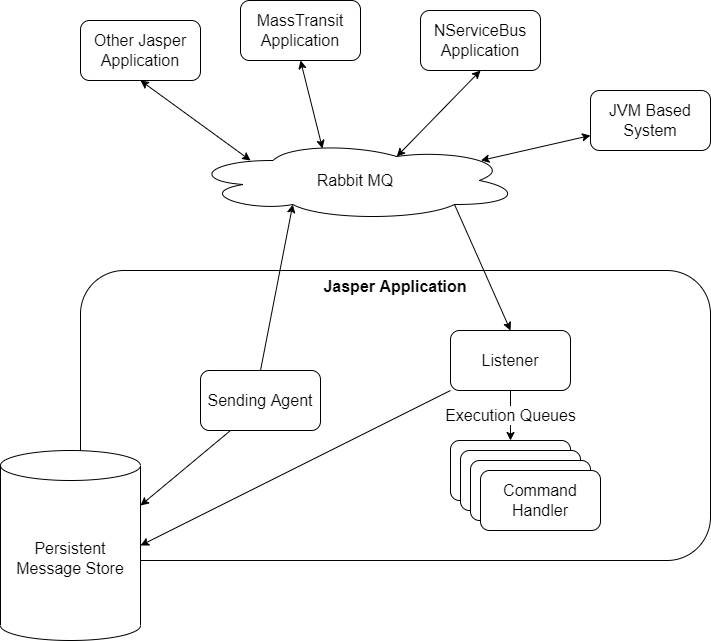Jasper as Messaging Bus
There's certainly some value in Jasper just being a command bus running inside of a single process, but now it's time to utilize Jasper to both publish and process messages received through external infrastructure like Rabbit MQ or Pulsar.
Terminology
To put this into perspective, here's how a Jasper application could be connected to the outside world:

TIP
The diagram above should just say "Message Handler" as Jasper makes no differentiation between commands or events, but Jeremy is being too lazy to fix the diagram.
Before going into any kind of detail about how to use Jasper messaging, let's talk about some terminology:
- Transport -- This refers to the support within Jasper for external messaging infrastructure tools like Rabbit MQ or Pulsar
- Endpoint -- A Jasper connection to some sort of external resource like a Rabbit MQ exchange or a Pulsar or Kafka topic. The Async API specification refers to this as a channel, and Jasper may very well change its nomenclature in the future to be consistent with Async API
- Sending Agent -- You won't use this directly in your own code, but Jasper's internal adapters to publish outgoing messages to transport endpoints
- Listener -- Again, an internal detail of Jasper that receives messages from external transport endpoints, and mediates between the transports and executing the message handlers
- Message Store -- Database storage for Jasper's inbox/outbox persistent messaging
- Durability Agent -- An internal subsystem in Jasper that runs in a background service to interact with the message store for Jasper's transactional inbox/outbox functionality
Ping/Pong Sample
To show off some of the messaging, let's just build a very simple "Ping/Pong" example that will exchange messages between two small .NET processes.
First off, I'm going to build out a very small shared library just to hold the messages we're going to exchange:
public class Ping
{
public int Number { get; set; }
}
public class Pong
{
public int Number { get; set; }
}
And next, I'll start a small Pinger service with the dotnet new worker template. There's just three pieces of code, starting with the boostrapping code:
using Jasper;
using Jasper.Transports.Tcp;
using Messages;
using Oakton;
using Pinger;
return await Host.CreateDefaultBuilder(args)
.UseJasper(opts =>
{
// Using Jasper's built in TCP transport
// listen to incoming messages at port 5580
opts.ListenAtPort(5580);
// route all Ping messages to port 5581
opts.PublishMessage<Ping>().ToPort(5581);
// Registering the hosted service here, but could do
// that with a separate call to IHostBuilder.ConfigureServices()
opts.Services.AddHostedService<Worker>();
})
.RunOaktonCommands(args);
and the Worker class that's just going to publish a new Ping message once a second:
using Jasper;
using Messages;
namespace Pinger;
public class Worker : BackgroundService
{
private readonly ILogger<Worker> _logger;
private readonly IMessagePublisher _publisher;
public Worker(ILogger<Worker> logger, IMessagePublisher publisher)
{
_logger = logger;
_publisher = publisher;
}
protected override async Task ExecuteAsync(CancellationToken stoppingToken)
{
var pingNumber = 1;
while (!stoppingToken.IsCancellationRequested)
{
await Task.Delay(1000, stoppingToken);
_logger.LogInformation("Sending Ping #{Number}", pingNumber);
await _publisher.PublishAsync(new Ping { Number = pingNumber });
pingNumber++;
}
}
}
and lastly a message handler for any Pong messages coming back from the Ponger we'll build next:
using Messages;
namespace Pinger;
public class PongHandler
{
public void Handle(Pong pong, ILogger<PongHandler> logger)
{
logger.LogInformation("Received Pong #{Number}", pong.Number);
}
}
Okay then, next let's move on to building the Ponger application. This time I'll use dotnet new console to start the new project, then add references to our Messages library and Jasper itself. For the bootstrapping, add this code:
using Jasper;
using Jasper.Transports.Tcp;
using Microsoft.Extensions.Hosting;
using Oakton;
return await Host.CreateDefaultBuilder(args)
.UseJasper(opts =>
{
// Using Jasper's built in TCP transport
opts.ListenAtPort(5581);
})
.RunOaktonCommands(args);
And a message handler for the Ping messages that will turn right around and shoot a Pong response right back to the original sender:
using Jasper;
using Messages;
using Microsoft.Extensions.Logging;
namespace Ponger;
public class PingHandler
{
public ValueTask Handle(Ping ping, ILogger<PingHandler> logger, IExecutionContext context)
{
logger.LogInformation("Got Ping #{Number}", ping.Number);
return context.RespondToSenderAsync(new Pong { Number = ping.Number });
}
}
public static class PingHandler
{
// Simple message handler for the PingMessage message type
public static ValueTask Handle(
// The first argument is assumed to be the message type
PingMessage message,
// Jasper supports method injection similar to ASP.Net Core MVC
// In this case though, IMessageContext is scoped to the message
// being handled
IExecutionContext context)
{
ConsoleWriter.Write(ConsoleColor.Blue, $"Got ping #{message.Number}");
var response = new PongMessage
{
Number = message.Number
};
// This usage will send the response message
// back to the original sender. Jasper uses message
// headers to embed the reply address for exactly
// this use case
return context.RespondToSenderAsync(response);
}
}
If I start up first the Ponger service, then the Pinger service, I'll see console output like this from Pinger:
info: Pinger.Worker[0]
Sending Ping #11
info: Pinger.PongHandler[0]
Received Pong #1
info: Jasper.Runtime.JasperRuntime[104]
Successfully processed message Pong#01817277-f692-42d5-a3e4-35d9b7d119fb from tcp://localhost:5581/
info: Pinger.PongHandler[0]
Received Pong #2
info: Jasper.Runtime.JasperRuntime[104]
Successfully processed message Pong#01817277-f699-4340-a59d-9616aee61cb8 from tcp://localhost:5581/
info: Pinger.PongHandler[0]
Received Pong #3
info: Jasper.Runtime.JasperRuntime[104]
Successfully processed message Pong#01817277-f699-48ea-988b-9e835bc53020 from tcp://localhost:5581/
info: Pinger.PongHandler[0]
and output like this in the Ponger process:
info: Ponger.PingHandler[0]
Got Ping #1
info: Jasper.Runtime.JasperRuntime[104]
Successfully processed message Ping#01817277-d673-4357-84e3-834c36f3446c from tcp://localhost:5580/
info: Ponger.PingHandler[0]
Got Ping #2
info: Jasper.Runtime.JasperRuntime[104]
Successfully processed message Ping#01817277-da61-4c9d-b381-6cda92038d41 from tcp://localhost:5580/
info: Ponger.PingHandler[0]
Got Ping #3